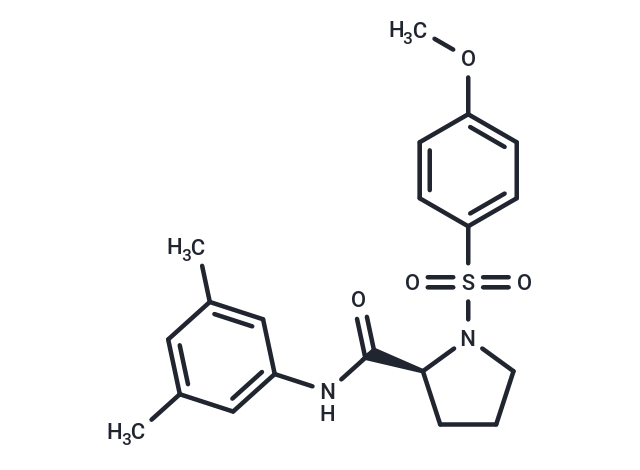
ACT-462206
CAS No. 1361321-96-1
ACT-462206( —— )
Catalog No. M34155 CAS No. 1361321-96-1
ACT-462206 is an orally available Orexin 1/Orexin 2 receptor antagonist that crosses the blood-brain barrier.ACT-462206 is highly potent and can be used in studies of sleep and anxiety.
Purity : >98% (HPLC)
 COA
COA
 Datasheet
Datasheet
 HNMR
HNMR
 HPLC
HPLC
 MSDS
MSDS
 Handing Instructions
Handing Instructions
| Size | Price / USD | Stock | Quantity |
| 2MG | 56 | Get Quote |


|
| 5MG | 81 | Get Quote |


|
| 10MG | 132 | Get Quote |


|
| 25MG | 270 | Get Quote |


|
| 50MG | 431 | Get Quote |


|
| 100MG | 671 | Get Quote |


|
| 500MG | 1341 | Get Quote |


|
| 1G | Get Quote | Get Quote |


|
Biological Information
-
Product NameACT-462206
-
NoteResearch use only, not for human use.
-
Brief DescriptionACT-462206 is an orally available Orexin 1/Orexin 2 receptor antagonist that crosses the blood-brain barrier.ACT-462206 is highly potent and can be used in studies of sleep and anxiety.
-
DescriptionACT-462206 is an orally active and potent dual Orexin 1/Orexin 2 receptor antagonist with IC50s of 60 nM (Orexin 1) and 11 nM (Orexin 2), respectively. ACT-462206 exhibits brain penetration properties, and can be used for insomnia, stress/anxiety-related disorders and addiction research.
-
In VitroOrexins are released in a Ca2+-sensitive manner at axonal terminals and can then bind to two closely related G-protein-coupled receptors (GPCRs): orexin receptor type 1 (OX1) and orexin receptor type 2 (OX2).ACT-462206 shows binding affinity with Kbs of 17 nM (hOX1), 2.4 nM (hOX2), 28 nM (rOX1), 9.9 nM (rOX2), 27 nM (dOX1), 4.2 nM (dOX2), respectively.ACT-462206 inhibits Orexin activity with IC50s of 60 nM (hOX1), 11 nM (hOX2), 48 nM (rOX1), 9.6 nM (rOX2), 68 nM (dOX1), 26 nM (dOX2), respectively.ACT-462206 inhibits CYP450 3A4T and 3A4M with IC50s of 15 μM and 29 μM, respectively.
-
In VivoACT-462206 (compound 24) (100 mg/kg; p.o.; sampling at 3 h) can go cross blood brain barrier, with concentrations are 2267 ng/mL and 1219 ng/g in plasma and brain, respectively in male Wistar rats. ACT-462206 (10-300 mg/kg; p.o.; single dose) shows sleep-promoting effects in male Wistar rats and in male Beagle dogs, with decreasing wakefulness and increasing non-rapid eye movement (non-REM) and REM sleep.ACT-462206 (100, 300 mg/kg; p.o.; single dose) exerts anxiolytic-like effects, decreases the fear-potentiated startle reflexes in response to a sudden loud noise in rats, reduces the socialstress-induced increases of locomotion, body temperature, and heart rate.Animal Model:Male Wistar rats Dosage:0, 10, 30, 100, 300 mg/kg Administration: Oral gavage; single dose Result:Decreased the latency to the first persistent episode of non-REM sleep (60 s) and the first persistent episode of REM sleep (30 s).Dose-dependently decreased total wake time and behavioral home cage activity (one-way ANOVA; p <0.001), while increasing REM and non-REM sleep times.
-
Synonyms——
-
PathwayOthers
-
TargetOther Targets
-
RecptorOX Receptor
-
Research Area——
-
Indication——
Chemical Information
-
CAS Number1361321-96-1
-
Formula Weight388.48
-
Molecular FormulaC20H24N2O4S
-
Purity>98% (HPLC)
-
SolubilityIn Vitro:?DMSO : ≥ 100 mg/mL (257.41 mM )
-
SMILESCOc1ccc(cc1)S(=O)(=O)N1CCC[C@H]1C(=O)Nc1cc(C)cc(C)c1
-
Chemical Name——
Shipping & Storage Information
-
Storage(-20℃)
-
ShippingWith Ice Pack
-
Stability≥ 2 years
Reference
1. Boss C, et al. Structure-activity relationship, biological, and pharmacological characterization of the proline sulfonamide ACT-462206: a potent, brain-penetrant dual orexin 1/orexin 2 receptor antagonist. ChemMedChem. 2014 Nov;9(11):2486-96. ?
molnova catalog



related products
-
PK150
PK150 shows oral bioavailability and antibacterial activity against several pathogenic strains at submicromolar concentrations.
-
13(S)-Hydroxyoctadec...
(±)13-HODE is one of the two racemic monohydroxy fatty acids resulting from the non-enzymatic oxidation of linoleic acid.
-
nordihydroguaiaretic...
Nordihydroguaiaretic acid (NDGA) is a phenolic antioxidant found in the leaves and twigs of the evergreen desert shrub, Larrea tridentata (Sesse and Moc. ex DC) Coville (creosote bush).



 Cart
Cart
 sales@molnova.com
sales@molnova.com


